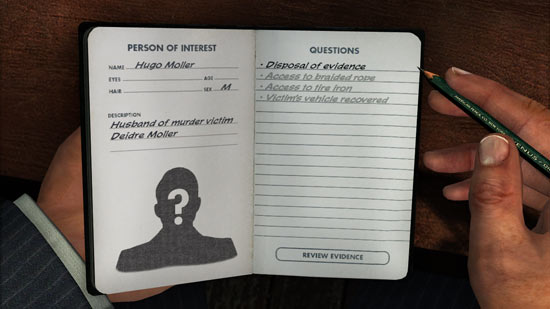Overview
Information is Power. In Memory Thief, players have the opportunity to see just how powerful that information is. As a detective investigating a series of crimes in a futuristic utopia, players witness firsthand this power. The ethical nature of 'memory theft' is questioned as players both use and investigate this powerful technology, and the effect it can have on society as a whole.
Core Mechanics
Memory Thief is a 2-D sidescroller presented as a cross between a typical point-and-click and a platformer. Memory Thief utilises dialogue systems similar to P&C games, while also using platforming for chase sequences and limited combat. The game is presented as a nonlinear series of stages (similar to FEZ) which are accessed through the police station, which functions as a 'hub world'. The game uses a number of real-world constraints - for example,. players cannot jump up or fall very far. Instead, ladders, stairs, and elevators are used to move up and down levels. This also allows the level design to mimic rooms and buildings similar to the game Gunpoint. As players progress through their assigned missions, their technology, items, and clothing can all be customised in order to better suit future missions. Similarly, players can also choose from a number of skill trees that affect their performance in missions. Many of these focus on memory manipulation and conversation, allowing players to further interact with NPCs in different ways.
Narrative
Memory Thief is a game that chooses to focus on delivering a lesson in the dangers of technology. Namely, the issues that can arise from a person losing their memories, calling into question who they really are. At the same time, the game attempts to portray the ethical issues surrounding it. As a supposed 'lawful' representative, players are given numerous situations where they can employ the same technology in order to 'fast-track' their way through situations. However, this can lead to narrative-constructed penalties, with their story changing depending on how well they 'toe the line'. It also opens the window for more strategies; players with information 'stolen' from suspects or criminals can also be used to the main character's advantage. Similarly, players may also find that some criminals have advance warning of their presence or intentions, due to their use of the same technology.Memory Thief utilises a similar level design system to Noir Syndrome, albeit differing in the navigation between levels.
Overview
Missing Pieces concerns the player solving a centuries-old mystery within a giant museum. As players roam through this wide open space, they come across clues and hints as to a sinister, overarching mystery. Presented from a first person perspectives, players take control of a guest trapped in the museum after closing, and what begins as an attempt to get out spirals out of control as events unfold. The key mechanic of this game hinges on the earlier visit that the player paid to the museum - which forms the prologue of the game.
Core Mechanics
Because the game is presented in a museum, there are a large amount of exhibits containing clues and information regarding the mystery. Players have to analyse exhibits, determining what is different with the exhibit since the last time they viewed it. Players are able to access these 'memories' by looking at images they took as well as their own memory of the exhibit. Some changes will be minor, while other changes (such as a moved component or new writing) are quite noticeable.
Narrative
Because Missing Pieces is hugely narratively focused, it relies on an interesting and deep narrative to carry the game. Players have to balance their knowledge of the environments and story thus far with what they are continually encountering. The player's knowledge forms a key component of the narrative - as players collect notes and information, they are able to form a more complete picture of how the story will progress. However, players may also use things they notice as hints, following trails for more information. These trails may be more obscure or harder to notice than other pieces of information.
Players keep information in a notebook similar to L.A. Noire.

Perception centers around the player's character, Viktor, who has the ability to shift between dimensions. Stuck in a mysterious facility with no knowledge of anything before, Viktor has to escape a series of areas as he makes his way out of wherever he is. When Viktor gets close to walls, with a simple button press he becomes a part of the wall. The type of wall that Viktor attaches to may have different effects. For example, if Viktor attaches to a bare wall, guards will spot him and raise the alarm. However, if the wall is patterned, players are able to blend in with a pattern and become undetectable. Viktor can also use his dimensional attributes in other ways. Viktor can move above guards and revert to the third dimension, dropping down and stunning guards. Some areas can only be accessed by Viktor changing dimension, as well as some puzzles. Likewise, some puzzles will only be solvable with Viktor being in the full 3rd dimension, requiring different solutions to 2-D puzzles. Progression in Perception hinges on the player taking full advantage of Viktor's abilities, as they won't be able to escape the facility unless they manage to fully master what Viktor has to offer. As the player gets further and further through the facility, they unlock more advanced abilities that allow Viktor to become more and more versatile.
Features Include:
Think in Every Dimension: Take advantage of the second dimension to access new areas, hide, and surprise enemies when they least expect it.
Puzzles everywhere: Solve puzzles involving physics, dimensions, and problem solving as you attempt to find out who and where you are.

Screenshot of A Link Between Worlds: a game with a similar dimension shifting mechanic.
(image courtesy of polygon.com)